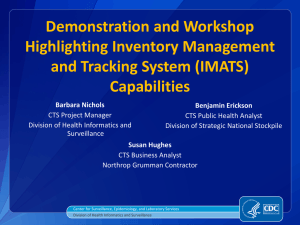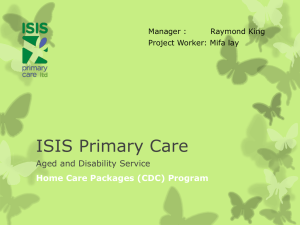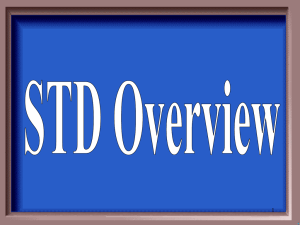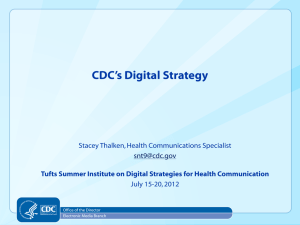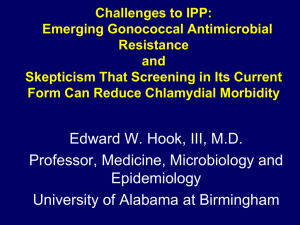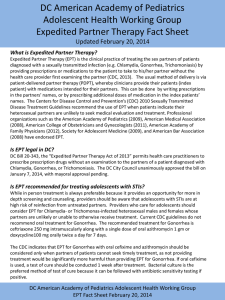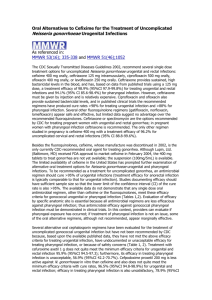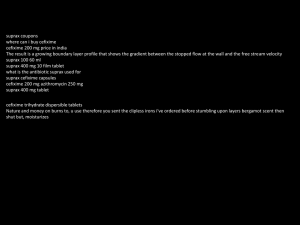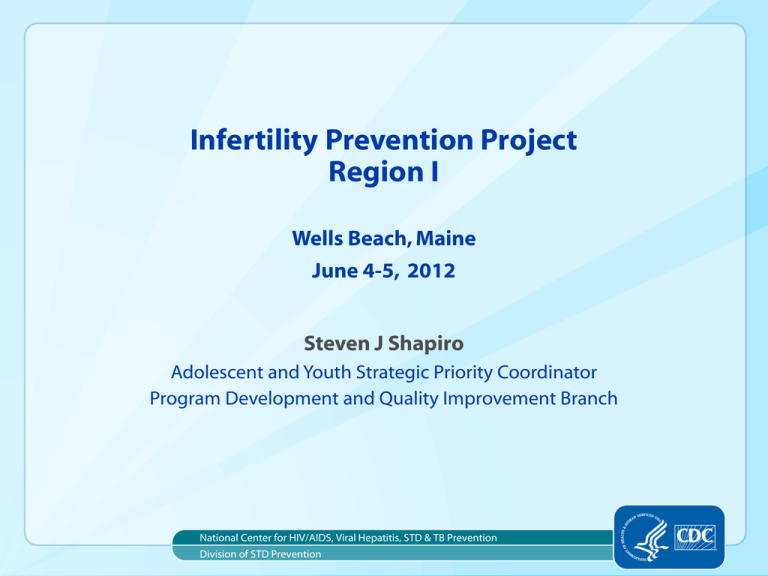
Infertility Prevention Project
Region I
Wells Beach, Maine
June 4-5, 2012
Steven J Shapiro
Adolescent and Youth Strategic Priority Coordinator
Program Development and Quality Improvement Branch
National Center for HIV/AIDS, Viral Hepatitis, STD & TB Prevention
Division of STD Prevention
Topics
National Infertility Prevention Project
CSPS 2013-2014
DSTDP Update
Health Care Reform
Gonorrhea
CSPS 2013
Streamlined Application
90 Day Application Period- Due August 20, 2012
Minimal Write-up
• Narrative and Required Tables (2-4) cannot exceed 30 pages
• Appendices limited to 20 pages
Funding Levels
Special Needs Budget (25% of total base award)
• DSTDP Priority;
• STD Prevention Investment sustainable without future funding;
• Have measureable outcomes and demonstrate effectiveness
CSPS 2013 (cont)
Performance Measures
IPP Letter of Concurrence
Additional Guidance
In-person attendance of three (3) representatives (project director,
program manager, epidemiologist) at regional [quadrant] or
national; STD prevention meetings.
IPP must be developed in partnership with family planning and
laboratory partners. Plans should be shared with the regional IPP
coordinator with sufficient time to address suggestions and
concerns.
CSPS 2012-
possible 0.189% rescission- reflected in final 30% of 2012 Funding Amount.
carry-forward requests for unspent 2011 funds should be submitted as soon as possible
CSPS 2014
Significant Changes
Streamline and Page Limit
Use 2012 Annual Data
Use Funding to support state and local plans
FOA Published March 1, 2013
Applications due May 13, 2013
Opportunities for input
Regional IPP meetings- NCSD
Townhall Meeting- Minneapolis
Consultation with National Partners
• Mid-July 2012
Email: DSTDPCSPS@cdc.gov by August 31, 2012
DSTDP Update
Division Realignment
Division of STD Prevention 2012
Program Coordinator Regions
NYC
CHI
Philly
Balt
S.F.
DC
L.A.
PR
Photo Title – Myriad Pro, Bold, Shadow, 20pt
AK
HI
Caption for photo, references, citations, or credits – Myriad Pro, 14pt
VI
Project Area Assignments
Region (Jurisdictions)
STD Program Coordinator STD Business Official
Western (16)
Steven Shapiro – Interim
404 -639-8868
sjs4@cdc.gov
Shean Johnson
404-639-6168
imq9@cdc.gov
Vickie Boazman-Holmes
404-639-6345
vmb2@cdc.gov
Shean Johnson
404-639-6168
imq9@cdc.gov
Sheldon Black
404-639-8653
sxb5@cdc.gov
David Byrum
404-639-1854
rdb4@cdc.gov
Dayne Collins – Interim
404-639-8188
zvl1@cdc.gov
Laurie Anderson – Interim
lla0@cdc.gov
4/1/12
David Byrum
404-639-1854
rdb4@cdc.gov
HHS Regions VIII, IX, X
Midwest (13)
HHS Regions V, VII + KY & WV
South
(12)
HHS Regions IV, VI
Northeast (18)
HHS Regions I, II, III
Geographic Distribution
2
4
1
9
11
NJ
3
M
2
DC 9
4
11
8
2
2
3
2
2
13
3
9
4
8
1
Legend
Norm
Fikes
Dan
George
Melinda
Salmon
John
Paffel
Jim
Lee
“Working in a Transformed Health Care System”
• States’ Progress
• Effect on STD Prevention
Health Reform Progress
www.statereforum.org
Massachusetts 52%
Connecticut 20%
Rhode Island 17%
Vermont 12%
Maine 10%
New Hampshire 4%
National 7%
National Academy for State Health Reform
Robert Wood Johnson Foundation
Data accessed June 2, 2012
Categories
Health Reform Coordination
Insurance Exchanges
Commercial Insurance
Eligibility and Enrollment
Provider Capacity
Benefit Design
Care Coordination
Data
Population Health
Public Engagement
Quality and Efficiency
“The Future of STD Prevention”
2012 and Beyond
Assurance
Functioning Surveillance Systems
Local Epidemiology Support
PCSI
Policy Development
Plan Programs using Data- all sorts of data
Assessment and Accountability
Monitoring
Evaluation
Safety Net Coverage
“The Future of STD Prevention”
2012 and Beyond
Strategic Priorities
National Prevention Strategy
National HIV/AIDS Strategy
IOM Women’s Preventative Services
Winnable Battles
Infrastructure and Capacity Building
• Surveillance, High Quality Data, Impactful Interventions, Structural
Enhancements, and Measurable Progress
Prevention through Healthcare
Sexual Health
STD Prevention Activities and Priorities
Activities
Screening/Testing
Linkage to Care (Treatment Assurance)
Partner Services
Health Promotion
Priorities
Adolescents and Youth
MSM
MDR GC
Congenital Syphilis
“ The Infertility Prevention Project
in a Transformed Health Care System”
“The Future of IPP”
An Infrastructure-driven Evaluation
o
o
o
IPP in the Project Areas
Environmental Scan
Recommendations for the Future
Decision Analysis Process
New OPA-CDC joint Training Center FOA
• Published April 12, 2012
• Applications due June 11, 2012
• Targeting August 1, 2012 for start date
IPP in 2014: ???
DRIP, DRIP, DRIP……
Proportion of isolates with
Elevated MICs to Cefixime (≥ 0.25 μg/ml)
n=52,785
1.4%
(n=77)
Percentage of isolates
*
* p trend < 0.05
Source: Gonococcal Isolate Surveillance Project (GISP)
Proportion of isolates with
Elevated MICs to Cefixime (≥ 0.25 μg/ml)
by Region
3.3%
(n=68)
n=52,785
Percentage of isolates
*
*
*
* p trend < 0.05
Source: Gonococcal Isolate Surveillance Project (GISP)
Proportion of isolates with
Elevated MICs to Cefixime (≥ 0.25 μg/ml)
by Sex of Sex Partner
n=50,873
Percentage of isolates
3.9%
(n=64)
*
* p trend < 0.05
Note: MSM = Men who have sex with men; MSW = Men who exclusively have sex with women;
Source: Gonococcal Isolate Surveillance Project (GISP)
PROGRAMMATIC RESPONSE
CHALLENGES
Major Challenges
Lack of alternative treatment options
Low awareness of problem
Other Challenges
Lack of clear laboratory criteria for resistance
GISP timeliness and sensitivity
Declining culture and AST capacity
Declining STD control resources
Low likelihood of preventing/controlling resistance
PROGRAMMATIC RESPONSE
WHAT ARE WE DOING?
Current CDC Activities
Development of Response Plan
Dual Therapy Clinical Trial
Surveillance
Increasing awareness
Publication and media outreach
Inclusion of NG in AMR discussion
Top 6 Health Menaces of 2011 (Men’s Health, Dec 2011)
CDC Public Health Grand Rounds (May 2012)
Testing of culture media for field conditions
Evaluating molecular mutations causing resistance
Conclusions
Cephalosporin-resistant gonorrhea likely to occur in US
Significant challenges exist
Start planning now to drive down GC morbidity
Start developing infrastructure to
Detect resistant strains
Slow their spread
Limit bad outcomes
ITS NOT JUST GONORRHEA……
Chlamydia—Rates by County, United States, 2010
Rate per 100,000
population
<300.0
(n = 1,962)
300.1–400.0 (n = 418)
>400.0
(n = 762)
Acknowledgements
CDC
Gail Bolan
John Papp
Kim Workowski
Tom Peterman
Kevin O’Connor
Dayne Collins
Sarah Kidd
Robert Kirkcaldy
Hillard Weinstock
Mark Stenger
Lizzi Torrone
Questions?
Thank you
For more information please contact Centers for Disease Control and Prevention
1600 Clifton Road NE, Atlanta, GA 30333
Telephone: 1-800-CDC-INFO (232-4636)/TTY: 1-888-232-6348
E-mail: cdcinfo@cdc.gov Web: http://www.cdc.gov
The findings and conclusions in this report are those of the authors and do not necessarily represent the official position of the
Centers for Disease Control and Prevention.
National Center for HIV/AIDS, Viral Hepatitis, STD , and TB Prevention
Division of STD Prevention
TRENDS IN CEPHALOSPORIN
SUSCEPTIBILITY:
INTERNATIONAL TRENDS
2000
Possible cefdinir (oral) treatment
failure in man with urethritis
(MIC=1)
2010
2 cefixime treatment
failures
(Cefixime MIC 0.25-0.5)
Pharyngeal treatment
failure
(Ceftriaxone MIC 0.125-0.25)
2 possible cefixime
treatment failures
(Cefixime MIC 0.25)
~30% with elevated
(≥0.06) ceftriaxone MICs
Decreased cephalosporin susceptibility:
2011
5 possible cefixime
treatment failures
At least 49 possible treatment
failures with oral cephalosporins
Treatment failures reported
Increasing MICs to cephalosporins
reported
TRENDS IN CEPHALOSPORIN
SUSCEPTIBILITY:
US TRENDS
Geographic Distribution of Cephalosporin* Alerts ,
2005
*Cefixime or Ceftriaxone
Geographic Distribution of Cephalosporin* Alerts,
2010
Orange Co.
San Diego
*Cefixime or Ceftriaxone
PROGRAMMATIC RESPONSE
Number of New Antimicrobial Agents Approved
Number of New Systemic Antibacterial Agents
Approved by the FDA, 1983–2007
Spellberg B, Guidos R, Gilbert D et al. Clin Infect Dis 2008
Recent Media Coverage of
Gonorrhea Resistance
•
http://www.theonion.com/articles/new-antibioticresistant-gonorrhea-strain-found,20926/
US Cephalosporin-Resistant Gonorrhea
Response Plan
Surveillance
Working Case Definition of Ceph-R NG
Treatment of initial cases
Public health investigation and case follow-up
Important Questions
Treatment
Dual Therapy Clinical Trial
But need additional trials, especially of oral agents, with efficacy for
pharyngeal GC, well tolerated
Case detection
Asking clinicians to report treatment failures – is this feasible/realistic?
Test-of-Cure
Under what conditions to recommend and how to operationalize?
When do Aptima GC tests turn negative after treatment?
Does this differ by anatomic site? (different organism load, different drug
efficacy, …)
Important Questions
Does susceptibility differ by anatomic site?
Does the pharynx play a role in resistance?
Does domestic selection pressure contribute to resistance?
Why are MSM more likely to be infected with resistant strains?
Is surveillance of urethral isolates adequate?
Treatment recommendation implications
GC Culture
What transport media or culture kit best maintains viability in the field?
Activities to Consider
Local and state health departments
•
•
•
•
Clinicians
•
•
•
•
Consider enhanced surveillance
Develop knowledge of where to obtain culture & AST
Maintain vigilance for treatment failures
Target and enhance GC control/prevention efforts
Screen for GC
Treat gonorrhea with recommend regimen
Maintain vigilance for treatment failures
Report treatment failure
Laboratorians
• Maintain culture capacity
• Report isolates with decreased susceptibility
Patients & at-risk populations
• Safer sex
• Seek care for symptoms, return if symptoms don’t resolve
Chlamydia – “In the Works”
Updating Estimates Manuscript
• 2.8 million cases in 2000…..????? In 2008
Identifying Predictors of Infection in Women 26+ w/NHANES
Collaborative Data Analysis with England’s HPA
• National Chlamydia Screening Programme
National STD Prevention Conference-Minneapolis March 2012
• At least 15 IPP-related posters/presentations accepted
• Pre-conference IPP Epi-Methods meeting ( PM 3/12/12)
Percentage of isolates
Distribution of MICs to Azithromycin, 2006–2010*
Minimum Inhibitory Concentrations (MICs), µg/ml
* Preliminary (Jan-Sept)
Percentage of isolates
Distribution of MICs to Azithromycin, 2006–2010*
Minimum Inhibitory Concentrations (MICs), µg/ml
* Preliminary (Jan-Sept)

